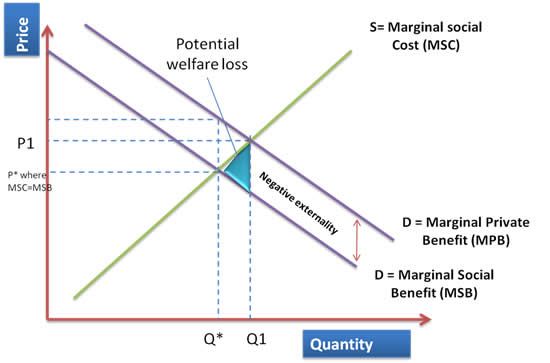Negative Consumption externalities
Negative consumption externalities occur due to consumption of certain goods and services.
Example, smoking. By smoking in public places, the consumer is creating negative externalities, in the form of passive smoking, for non-smokers. Other examples include using fossil fuels that pollute atmosphere, playing loud music and disturbing neighbours, discarding garbage in public places.

In negative consumption externality, the MPB is not reflecting social benefit and thus MSB lies below MPB. The vertical difference between MPB and MSB is the negative externality. The optimal level of consumption is where MSB=MSC i.e. Q*. However the negative externality is being ignored and thus there is an over consumption of the goods at Q1.
Correcting negative consumption externalities
Advertising: Government can using persuasive advertising/awareness campaigns to alert the consumers and influence them reduce their consumption. This will lead to a shift of MPB curve to the left thus reducing the gap between socially optimal level of consumption Q* and Q1.
Legislations and regulations: Government can also pass legislations or impose fines on certain activities which create nuisance for the societies. Many countries already have banned smoking in public places.
Imposing indirect taxes: By putting taxes on the production of goods that cause negative consumption externalities, government can reduce the supply. By putting taxes, the supply curve(MSC) will shift upwards to MSC+tax. This will reduce the gap between Q* and Q1.
Watch a Video





